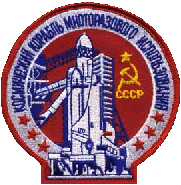
The Soviet MKS (Mnogorazovaya
Kosmicheskaya Sistema) Space
Shuttle Program
Optimised
for 1024x768 display

Last updated - 22/6/2008: Baikal
- yes, it was OK-1K1 'Buran' all along
OK-ML gets some much-needed TLC
OK-GLI gets a boat
ride to German aerospace museum (Speyer Technik)
Once
upon a time the Russians had their own Shuttle program, which was in many ways far
superior to the US version. Its one and only flight took place on the 15th of
November, 1988 from Launch Complex 110's Pad No. 37 [the adjacent pad, No. 38 was never used] when OK-1K1 "Buran"
flew a triumphant two-orbit mission under computer control. Alas, with the collapse
of the Soviet Union the money and political interest ran out. Now their expensive
orbiters gather dust, sad relics of the Cold War destined never to fly again.
The Soviets built a bewildering number of airframes - both
partial and complete - for every sort of vibration, electrical and static test imaginable
to make up for their lack of computer simulation. Identification is consequently
difficult, especially as almost right up to Buran's first flight twin jet engines were to
be mounted either side of the vertical stabiliser for use on landing and all airframes
included the cut-outs necessary to hold them.
*** MKS means 'Reusable Space
System'; OK stands for Orbitalny Korabl, or 'Orbital Craft'
*** Buran is interpreted in the West as 'Snowstorm', but a better
translation is probably 'Blizzard'
Major test-airframes, designations and functions:
OK-GLI - (BTS-002) - 24 manned takeoff/landing tests;
moved to German museum
OK-ML - (OK-ML1) - static/dynamic/pad tests; displayed as tourist
attraction in Baikonour
OK-MT -
(OK-ML2) - static/pad tests; stored at building 112A/MZK in Baikonour
OK-KS -
fuselage for electrical/software integration tests; stored in RSC Energia museum, Moscow
OK-TVA - structural test article; now tourist attraction
in Gorky Park, Moscow
OK-TVI -
structural fuselage for static/electrical/radiation tests; stored at NIIKhIMMash in Moscow
Planned space-worthy vehicles:
OK-1K1, 1.01 - "Buran":
1st and only flight, Nov 15th, 1988; destroyed in 2002 (see below)
OK-2K1, 1.02 - "Burya"(?): equipped for manned flights; still stored at building
112A/MZK in Baikonour
OK-1K2, 2.01 - partially completed, purchased by German aviation museum - (Speyer Technik)
OK-2K2, 2.02 - partially completed, then scrapped...
OK-3K2, 2.03 - partially completed, then scrapped...
May 12th, 2002: Disaster at Baikonour's Building 112/MIK
Hangar collapse at Baikonour destroys spare Energiya booster and OK-1K1 Buran
A brief flurry of excitement was caused in mid-2001 with the following article, in which it was reported the Russian government proposed resurrecting the MKS program, but the scheme was never likely to succeed and the project's death-knell was well and truly sounded on May 12th, 2002 with the crash of falling steel in Building 112/MIK. There was even a rumour that the roof collapse was engineered to cover up Buran's sale to the Chinese!
Update:
Finally,
some better photographs of the damage at Building 112/MIK have appeared. The
Buran/Energia stack WAS completely flattened. Buran's port aft RCS pod is visible on
right-edge frame of bbur89.jpg. The tiles surrounding the cockpit windows in
bbur90.jpg provide proof that it was a flight-worthy orbiter underneath all that
rubble. Seeing as there was only one such vehicle stored at in Bldg 112, the debate
(such as it was) looks settled:
Here are a few photos to remind us of the glories of the past, and a glimpse of what might have been. I'd like a close-up launch photo, but the few I've seen so far are rubbish. Anybody got a GOOD one?
OK-GLI , the so-called 'analogue Buran' coming in for a landing: 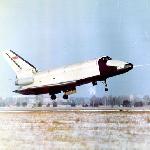
Energiya 1L/OK-1K1 "Buran" in the Shuttle Assembly
Building (MZK): 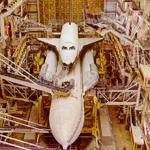
Heading for Area 110/Pad 37 on
the horizontal transporter: 
Arriving at Launch Pad
37: 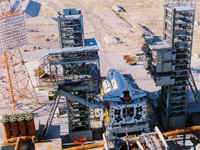
Two excellent views of Energiya 1L/OK-1K1 "Buran" on the Pad...
From the Back: 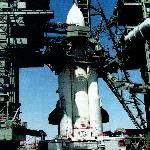 ...and the Front:
...and the Front:
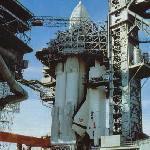
Booster Ignition!: 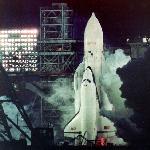 On final approach:
On final approach: 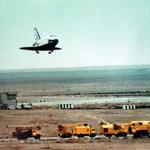
Touchdown:  Shortly after landing:
Shortly after landing: 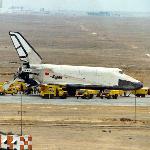
WHERE ARE THEY NOW?
Here are a few pictures dating back to ca 1995-97 showing the various orbiters and full-scale test airframes, most in long-term storage at the Baikonour cosmodrome in Kazakhstan. Very few pictures dealing with the MKS program were ever released by the Soviets, most minus accurate captions or dates. Unfortunately, the collapse of the USSR hasn't changed that policy: the Russians are just as selfish and miserly although their photographic archives must be bulging with spectacular images of their Salyut space stations, their moon rocket and Zond programs, the early manned missions and so on, to name but a few. Lying and concealment are a difficult habit for them to break. Perhaps only large cash bribes will do the trick and overcome their mean-spiritedness. Only time will tell.
The first photo shows OK-1K1, the actual
"Buran" orbiter used for the program's one and only unmanned flight on November
15th 1988, shortly after the mission. Unconfirmed reports say it suffered enough damage
during re-entry to make flying it again impossible, but who knows the truth? Little
appears wrong on the outside apart from the stained tiles...
Next-door is a second, later pic of "Buran" atop one of the left-over Energiya
boosters, where it was moved to make room for work on the International Space Station
before she was destroyed.
The third photo reputedly shows OK-2K1, the second flight-worthy vehicle built, supposedly nicknamed Ptichka, or 'Little Bird'. I would have thought that the Soviets must have been expecting to launch their 2nd (crew-capable) vehicle within a year or so at most and that it would have been named and painted around that time, although it appears not if this is in fact that vehicle. Note that there is no name on the fuselage. Maybe they were going to leave it until the last moment, or still hadn't made up their minds what to call it. Personally, I have never believed the Russians would have come up with such a daft name. It displays none of their fondness for stolid, unimaginative names. Burya - 'Storm' or 'Tempest' - has been put forward as a better alternative; however, there is no proof this was ever formally considered, let alone approved.
The forth is OK-ML, the (un-named) full-scale engineering test article. She was left decaying in the open a few hundred metres from Bldg 112 for several years, but is now at long last being repaired and cleaned up prior to being placed on display: photo 4B, although she has been painted to make her look like Buran in a cynical effort to fool visitors(!)
The fifth is OK-MT, the forth airframe assembled , perhaps also nicknamed "Baikal" - although it carries no such name. Visible on either side of the tail are cut-outs where two mock-up Lyulka AL-31 jet engines were originally mounted, although no attempt was ever made to fly her under her own power.
The sixth photo appeared in Aviation Week &
Space Technology, claiming that the orbiter in the foreground was "Buran"
itself, although this is demonstrably untrue. It is OK-ML.
As to the identity of the second vehicle: the red payload-bay
door handling fixtures and lack of black tiles on the nose make it OK-MT, most assuredly
NOT OK-2K1.
The Baikal/Buran naming mystery is finally cleared up (see below):
This first video image shows
OK-2K1 during rollout to the pad for crew evacuation and fit-tests during May 1991. Note
the two extra thrusters forward of the cluster of four larger openings exhibited by
"Buran" and the other test vehicles. It was originally thought two K1's
were built, but now it looks as if there was only one. Note the poor/incomplete
condition of her thermal protection system, which was finished later.
Lastly, an intriguing still of an orbiter with "Baikal"
painted on the side being moved on a wheeled transporter. These appeared on the
Molniya "Buran" site dealing with the faked launch in 1992 of the second
orbiter, "Baikals", on a failed mission to Mir. Of course, this never
happened, but what is interesting is that the images of that 'launch' have the name
"Baikal" in different lettering to this video grab. This vehicle itself
clearly had the name physically painted on, as opposed to the images themselves being
manipulated. The nose also lacks OK-2K1's two small vernier-thrusters, almost
certainly making it OK-1K1 "Buran".
*** As recently confirmed in 2007, a name-change took place very
late in the program [in April or May 1988](?) probably to conceal OK-1K1's true name as
long as possible - which, of course, worked.
1/ OK-1K1 "Buran":  2/ Energia/"Buran":
2/ Energia/"Buran": 
4B/
OK-ML[work]: .jpg) 5/ OK-MT:
5/ OK-MT: .jpg)
6/
OK-ML [front] & OK-MT
[rear]: 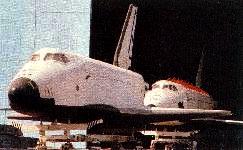
Video frames 1 & 2:
OK-2K1's pad evacuation/fit-test rollout in May 1991: 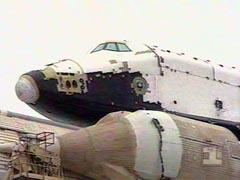
Taken years earlier, the enigmatic Baikal footage
- yes, it was "Buran" all along: 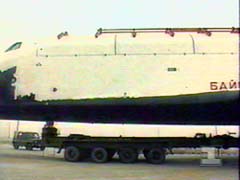
* Recommended reading: 'Energiya-Buran -
The Soviet Space Shuttle' by Bart Hendrickx & Bert Vis
Springer/Praxis Books, 2007
To date, this is THE definitive book regarding the
Energiya/Buran system, with reams of information documenting
Buran's tortured history which has only come to light in recent years. My sole
complaint is that the photos are all B&W and
minimally labeled and there is no accompanying DVD. Hopefully one day there will be
a Western-quality book with hi-res color
pictures, not just of Buran but all the other vehicles and the mission itself. The
photos on the www.buran.ru website are pretty
ordinary. I can only hope they are 'teasers' and those on the DVD they sell are
better.
"Three Days at Woomera"
This article appeared in the Nov 2001 issue of 'Novosti Kosmonavtiki'
* For the Russian version, click here: page 1 and here: page 2
* To read the original in English, visit here
US photo-research visits & the Cassini launch to Saturn
In 1995
and 1997 I was fortunate enough to visit JSC Media Relations branch to search through
their photo-archives for hard-to-find Space Shuttle images, and also took in the launch of
the Cassini
probe to Saturn.
Here
are a few photos I took along the way:
![]() And lastly, this way to my
Science Fiction page!
And lastly, this way to my
Science Fiction page!
Found any pesky bugs?  LET ME KNOW:
LET ME KNOW: pargoo@netspace.net.au
pargoo@netspace.net.au